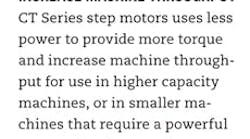Motors and drives eat lots of energy. This is not good. Critical energy issues in the U.S. make headlines every day, and cost consumers billions of dollars. Conservation and new technologies are the answer to achieve greater efficiencies.
Did you know that manufacturing uses 25% of energy in the U.S.? That data comes from Anne Cooney, vice president, Power Conversion Division, Siemens Energy & Automation.
Motors and drives play a big role in energy consumption, so many companies have taken on the challenge of producing more energy-efficient motors and drives. “Efficiencies achieved via conventional, diecast aluminum rotor technology have peaked, so improved efficiencies require development of new technologies such as the copper rotor,” says Cooney. “Copper rotor technology permits high levels of efficiency in a motor with the same size as standard-efficiency motors, defined by the Environmental Protection Act of 1992. Siemens mass produces diecast copper rotors. The copper rotor design is one of the key elements that enable these motors to exceed NEMA Premium efficiency. Diecast copper rotor manufacturing technology is a relatively new field, especially in production quantities in sizes needed for 1 to 20 hp motors. Casting copper rotors presented a real manufacturing challenge. Due to the high melting point of copper —1,985 °F versus 1,221 °F for aluminum—considerable development engineering was needed to control the extremely high stresses imposed on the manufacturing equipment.” Other companies are catching onto the technology, and also are producing high efficiency standard motors.
Over at Portescap, Dr. Norbert Veignat, managing director, Europe, feels is the key to new motors’ success is reducing their overall size. “In the motor arena below 200 W, we’ve seen a trend in miniaturization, especially in portable medical equipment and instrumentation, and the leading motor manufacturers have responded by designing and building small DC, BLDC and stepper motors to meet this need,” says Veignat. “Advances in motor technologies have increased torque density and position resolution via magnetoresistive encoders, reducing the size of the motor.”
Motor energy efficiency also is on the mind of designers at Danfoss Drives. “A big trend in drives is the expansion into higher horsepower applications,” says Peter Kartanos, Danfoss’ high-horsepower drives product manager. “With energy efficiency becoming an ever greater concern, variable-frequency drives offer opportunities for energy savings in installations that use large fans, pumps, and compressors. At the same time, these applications can also benefit from greater control and flexibility, both of which can be accomplished using drives.”
- Servos for Motion Control
- Increase Machine Throughput
- Easy to Commission
- Integrated Modular Drives
- Servo Drives
- Decentralized Control
- Encoders in the Motors
- Only What You Need
- More Torque, No Gearbox
- Microstepping Driver
- Servomotor Feedback System
- Standalone Steppers
- OEM Gearmotors
- Flat Linear Motors
- Servo Controller/Drive
- High-Power Motion Control
- Drive in a Box
- Digital Servo Drive
- Half the Space
- Be Cool
- New Drives
- Power Control
- More Torque
- Watch Your Speed
- Sure-Footed Stepping
- Can’t Lose It
- Rated XXX
- Testing Small Rotary Devices
- Tiny Motors
- Networked Control of Drives
- Drives Cut Costs
- Intelligent Plug-In Servo Drive




